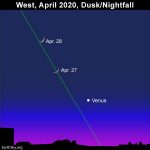
Late April offers the planet Venus at its brightest in the evening sky for all of 2020, a glorious evening “star.” No matter where you live, look west after sunset for this bright planet. Venus is now nearly 3 times brighter than it was at its faintest some months ago. And that’s saying something, because Venus always ranks as the second-brightest heavenly body in the night sky (after the moon). It easily outshines all other planets and stars.
Venus will reach its greatest illuminated extent – when the lighted portion of the planet covers the greatest area of our sky’s dome – on April 28, 2020 at 01:00 Universal Time (April 27 at 8 p.m. CDT). It’s at or near greatest illuminated extent that Venus shines most brightly.
Venus’ reign in the evening sky started on August 14, 2019, and will come to an end on June 3, 2020. We know you might have seen Venus already. But watch for it these next several days, at dusk and early evening. Venus will dazzle you!
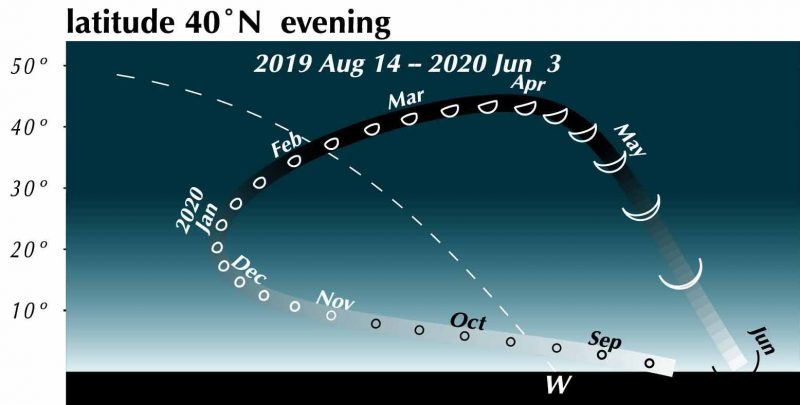
Chart by Guy Ottewell via his blog. The chart depicts Venus’ disk size and phase in the evening sky from superior conjunction (August 14, 2019) to inferior conjunction (June 3, 2020).
Did you know that Venus shows phases, just as the moon does? It might be hard to believe, but Venus shines at its brightest in our sky when displaying a crescent phase (approximately 25 percent illuminated). It’s as a crescent that Venus’ daytime side, or illuminated side, covers the maximum area of sky (greatest illuminated extent).
Although you need a telescope to view Venus’ disk and changing phases, the planet is always smallest (covers the smallest area of our sky’s dome) when Venus first enters the evening sky. That’s despite the fact that Venus is then at the full phase, just past superior conjunction or located across the solar system from us, just peeking out after being behind the sun as viewed from Earth. See the diagram at the bottom of this post. Superior conjunction last happened last August. Then Venus was on the far side of the sun from us, and farthest from Earth.
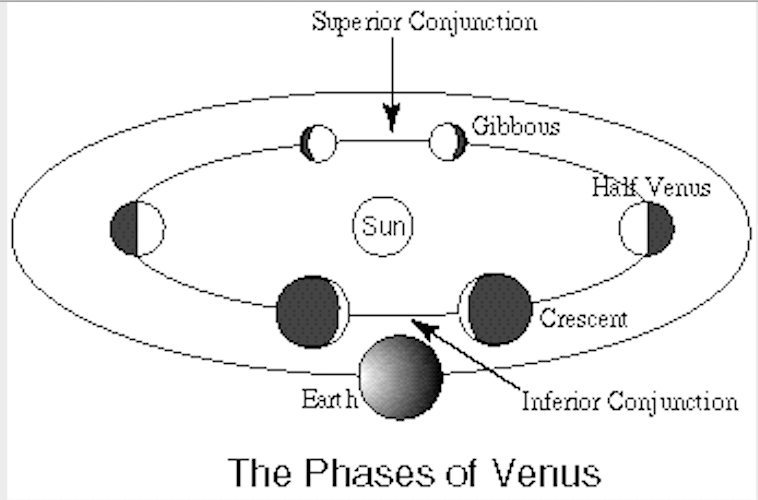
Superior conjunction – when Venus swept behind the sun from Earth – last happened on August 14, 2019. Just before and after that time, we saw a nearly full Venus. Inferior conjunction – when Venus will sweep between us and the sun – will happen next on June 3, 2020. Just before and after, we’ll see a crescent Venus. Image via UCLA.
Venus’ disk is largest when Venus leaves the evening sky some 292 days after superior conjunction. That’s how long it takes for Venus – in its smaller, faster orbit – to travel around in its orbit of the sun, until it sweeps between the sun and Earth at inferior conjunction. Then – phase-wise – Venus is at new phase.
When at inferior conjunction, the night side of Venus is facing Earth, and Venus is again lost in the sun’s glare. Thus we don’t see the planet (usually).
Inferior conjunction will next happen on June 3.
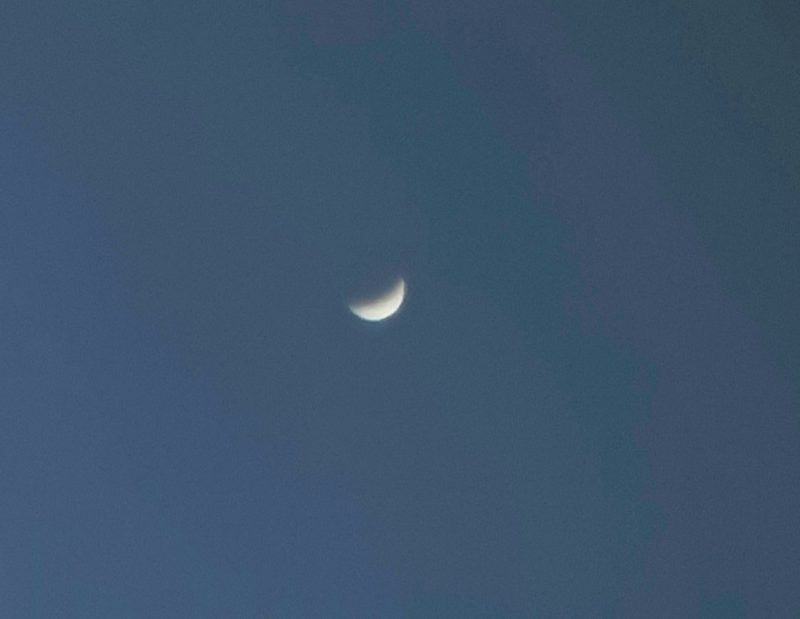
View larger at EarthSky Community Photos. | Did you think this was the moon? Aurelian Neacsu zoomed in on planet Venus from Visina, Romania, on April 24, 2020. Aurelian wrote: “The brightest planet during daytime … Phase 30%, 40 days before inferior conjunction.” Thank you, Aurelian.
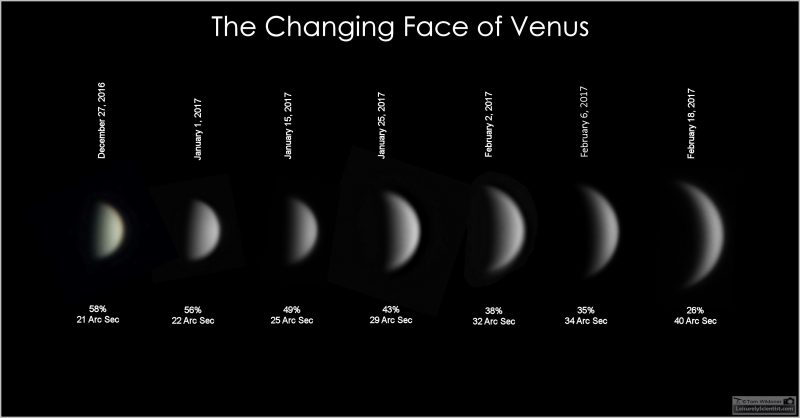
This collection of Venus images from December 2016 to February 2017 shows how the size and phase of Venus changes as the planet nears its time of inferior conjunction, that is, its time of passing more or less between the sun and Earth. Image via our friend Tom Wildoner at the Dark Side Observatory.
Venus’ greatest illuminated extent in the evening sky – happening now – always happens about 36 days after Venus reaches greatest eastern (evening) elongation (in this case March 24, 2020), and some 36 days before Venus sweeps to inferior conjunction (June 3, 2020). At its greatest elongation, in either the evening or morning sky, Venus’ disk is approximately 50 percent covered over in sunshine.
On the other hand, Venus’ greatest illuminated extent in the morning sky (July 10, 2020) comes some 36 days after inferior conjunction (June 3, 2020) yet 36 days before reaching greatest western (morning) elongation (August 13, 2020). Isn’t it great how orderly the heavens are?
Let the golden triangle help you to remember these Venus’ milestones. The two base angles equal 72 degrees and the apex angle equals 36 degrees. Quite by coincidence, Venus’ greatest elongations happen some 72 days before and after inferior conjunction, and Venus’ greatest illuminated extent happens some 36 days before and after inferior conjunction.
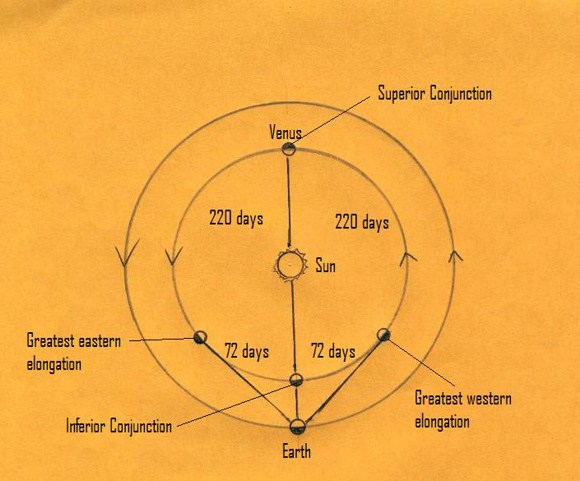
Earth and Venus orbit the sun counterclockwise as seen from the north side of the solar system. Venus reaches its greatest eastern elongation in the evening sky about 72 days before inferior conjunction and its greatest western elongation in the morning sky about 72 days after inferior conjunction. Greatest illuminated extent for Venus comes midway between a greatest elongation and an inferior conjunction.
Bottom line: Look west after sunset in the days (and weeks) around April 27 and 28, 2020 to behold dazzling Venus, the sky’s brightest planet shining at her brightest best in the evening sky!
from EarthSky https://ift.tt/2KEP6O1

Late April offers the planet Venus at its brightest in the evening sky for all of 2020, a glorious evening “star.” No matter where you live, look west after sunset for this bright planet. Venus is now nearly 3 times brighter than it was at its faintest some months ago. And that’s saying something, because Venus always ranks as the second-brightest heavenly body in the night sky (after the moon). It easily outshines all other planets and stars.
Venus will reach its greatest illuminated extent – when the lighted portion of the planet covers the greatest area of our sky’s dome – on April 28, 2020 at 01:00 Universal Time (April 27 at 8 p.m. CDT). It’s at or near greatest illuminated extent that Venus shines most brightly.
Venus’ reign in the evening sky started on August 14, 2019, and will come to an end on June 3, 2020. We know you might have seen Venus already. But watch for it these next several days, at dusk and early evening. Venus will dazzle you!

Chart by Guy Ottewell via his blog. The chart depicts Venus’ disk size and phase in the evening sky from superior conjunction (August 14, 2019) to inferior conjunction (June 3, 2020).
Did you know that Venus shows phases, just as the moon does? It might be hard to believe, but Venus shines at its brightest in our sky when displaying a crescent phase (approximately 25 percent illuminated). It’s as a crescent that Venus’ daytime side, or illuminated side, covers the maximum area of sky (greatest illuminated extent).
Although you need a telescope to view Venus’ disk and changing phases, the planet is always smallest (covers the smallest area of our sky’s dome) when Venus first enters the evening sky. That’s despite the fact that Venus is then at the full phase, just past superior conjunction or located across the solar system from us, just peeking out after being behind the sun as viewed from Earth. See the diagram at the bottom of this post. Superior conjunction last happened last August. Then Venus was on the far side of the sun from us, and farthest from Earth.

Superior conjunction – when Venus swept behind the sun from Earth – last happened on August 14, 2019. Just before and after that time, we saw a nearly full Venus. Inferior conjunction – when Venus will sweep between us and the sun – will happen next on June 3, 2020. Just before and after, we’ll see a crescent Venus. Image via UCLA.
Venus’ disk is largest when Venus leaves the evening sky some 292 days after superior conjunction. That’s how long it takes for Venus – in its smaller, faster orbit – to travel around in its orbit of the sun, until it sweeps between the sun and Earth at inferior conjunction. Then – phase-wise – Venus is at new phase.
When at inferior conjunction, the night side of Venus is facing Earth, and Venus is again lost in the sun’s glare. Thus we don’t see the planet (usually).
Inferior conjunction will next happen on June 3.

View larger at EarthSky Community Photos. | Did you think this was the moon? Aurelian Neacsu zoomed in on planet Venus from Visina, Romania, on April 24, 2020. Aurelian wrote: “The brightest planet during daytime … Phase 30%, 40 days before inferior conjunction.” Thank you, Aurelian.

This collection of Venus images from December 2016 to February 2017 shows how the size and phase of Venus changes as the planet nears its time of inferior conjunction, that is, its time of passing more or less between the sun and Earth. Image via our friend Tom Wildoner at the Dark Side Observatory.
Venus’ greatest illuminated extent in the evening sky – happening now – always happens about 36 days after Venus reaches greatest eastern (evening) elongation (in this case March 24, 2020), and some 36 days before Venus sweeps to inferior conjunction (June 3, 2020). At its greatest elongation, in either the evening or morning sky, Venus’ disk is approximately 50 percent covered over in sunshine.
On the other hand, Venus’ greatest illuminated extent in the morning sky (July 10, 2020) comes some 36 days after inferior conjunction (June 3, 2020) yet 36 days before reaching greatest western (morning) elongation (August 13, 2020). Isn’t it great how orderly the heavens are?
Let the golden triangle help you to remember these Venus’ milestones. The two base angles equal 72 degrees and the apex angle equals 36 degrees. Quite by coincidence, Venus’ greatest elongations happen some 72 days before and after inferior conjunction, and Venus’ greatest illuminated extent happens some 36 days before and after inferior conjunction.

Earth and Venus orbit the sun counterclockwise as seen from the north side of the solar system. Venus reaches its greatest eastern elongation in the evening sky about 72 days before inferior conjunction and its greatest western elongation in the morning sky about 72 days after inferior conjunction. Greatest illuminated extent for Venus comes midway between a greatest elongation and an inferior conjunction.
Bottom line: Look west after sunset in the days (and weeks) around April 27 and 28, 2020 to behold dazzling Venus, the sky’s brightest planet shining at her brightest best in the evening sky!
from EarthSky https://ift.tt/2KEP6O1


Aucun commentaire:
Enregistrer un commentaire